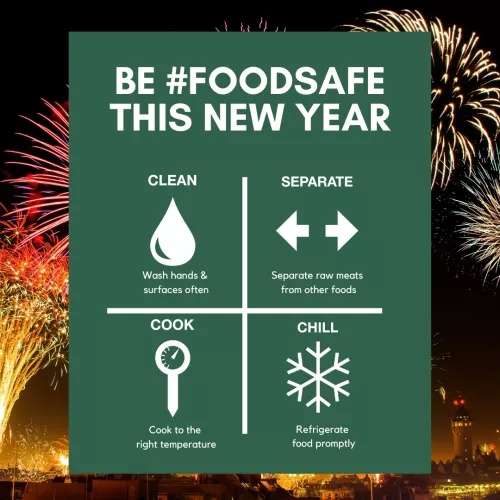
Blog post
Ringing in 2023 with food safety tips for those living with kidney disease

As January comes around, many people often set goals to promote healthier habits. This can mean changing up your eating habits, spending time in the gym or learning to prepare new dishes. For people living with kidney disease, it is important to tailor your New Year's goals to ensure they are maintainable and prioritize safety, as you may have a weakened immune system due to your kidneys not operating at their full capacity.
In addition to setting healthier eating goals for 2023, it is vital to consider food safety to keep you and your loved ones healthy. According to the Centers for Disease Control and Prevention, 48 million people get sick, 128,000 are hospitalized and 3,000 die from foodborne infection and illness in the United States each year.
To help you protect yourself from foodborne illness, the American Kidney Fund's (AKF) Kidney Kitchen® collaborator, USDA's Food Safety and Inspection Service (FSIS), has handy tips for how to handle food safely:
- Clean – Start with clean hands, utensils and surfaces. Wash them throughout and after food preparation to ensure bacteria do not spread. Be sure to wash your cutting boards, dishes and countertops with hot, soapy water after preparing each food item and before you go on to the next item. Cutting boards can be sanitized with a solution of one tablespoon of unscented, liquid chlorine bleach per gallon of water.
- Separate – Cross-contamination is the transfer of harmful bacteria to food from other foods, cutting boards and utensils, and it happens when those items are not handled properly. Keep raw meat and poultry separate from other foods, whether at the grocery store or in your home kitchen.
- Cook – Always cook food, particularly meat, to a safe minimum internal temperature as measured by a food thermometer to ensure harmful bacteria have been killed.
- Chill – Keep perishable foods at a safe temperature below 40°F. Follow the 2-hour rule and do not leave perishable foods at room temperature for more than 2 hours (or 1 hour if exposed to temperatures above 90°F). Plan to use or freeze leftovers within 4 days, and be sure to reheat those leftovers to 165°F.
Another important tip to keep in mind: stay away from the danger zone. The "danger zone" is between 40°F and 140°F, the temperature range in which bacteria multiply rapidly. When perishable foods are left out for more than 2 hours, bacteria can multiply to dangerous levels that make your food unsafe to consume. Keeping cold foods cold (below 40°F) and hot foods hot (above 140°F) keeps foods safe from bacteria multiplying.
Find more food safety tips specifically for those living with kidney disease on Kidney Kitchen and additional information for handling food safely on the FSIS website. With these simple steps to food safety, you are all set to go forth and carry out your New Year's resolutions.
Cheers to 2023!
Food Safety Specialists are Here for You
Need more information about food safety? Call the USDA Meat and Poultry Hotline at 888-MPHotline (888-674-6854) to talk to a food safety specialist, email MPHotline@usda.gov or chat live at ask.usda.gov from 10 a.m. to 6 p.m. ET, Monday through Friday.





